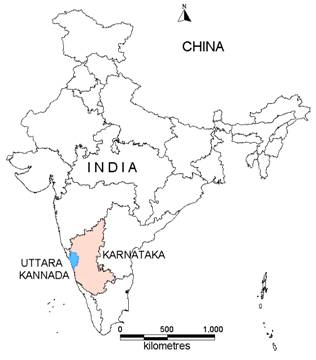T. V. Ramachandra *, Senior Member, IEEE, Anindita Dasgupta, Uttam Kumar, Student Member, IEEE,
Bharath H Aithal, Student Member, IEEE, P. G. Diwakar and N. V. Joshi
|
|
STUDY AREA AND DATA
The Uttara Kannada district lies 74°9' to 75°10' E longitude and 13°55' to 15°31' N latitude, extending over an area of 10,291 km2 in the mid-western part of Karnataka state (Fig. 2). It accounts for 5.37 % of the total area of the state with a population above 1.2 million [23]. This region has gentle undulating hills, rising steeply from a narrow coastal strip bordering the Arabian sea to a plateau at an altitude of 500 m with occasional hills rising above 600–860m.

Fig. 2. Uttara Kannada district, Karnataka, India
This district, with 11 taluks, can be broadly categorised into three distinct regions –– coastal lands (Karwar, Ankola, Kumta, Honnavar and Bhatkal taluks), mostly forested Sahyadrian interior (Supa, Yellapur, Sirsi and Siddapur taluks) and the eastern margin where the table land begins (Haliyal, Yellapur and Mundgod taluks). Climatic conditions range from arid to humid due to physiographic conditions ranging from plains, mountains to coast.
Survey of India (SOI) toposheets of 1:50000 and 1:250000 scales were used to generate base layers – district and taluk boundaries, water bodies, drainage network, etc. Field data were collected with a handheld GPS. RS data used in the study were Landsat MSS (1973, spatial resolution – 79m), Landsat TM (1989, spatial resolution – 30m), Landsat ETM+ (2000, spatial resolution – 30m) [downloaded from Global Land Cover Facility, http://www.landcover.org] and LISS-III Multi-spectral (2004, spatial resolution – 23.5m) procured from NRSC, Hyderabad, India. Google Earth data (http://earth.google.com) served in pre and post classification process and validation of the results.
Environmental data such as precipitation of wettest month were downloaded from WorldClim – Global Climate Data [http://www.worldclim.org/bioclim]. Other environmental layers (Aspect, DEM, Flow accumulation, Flow direction, Slope, Compound Topographic Index) used for modelling landslide were obtained from USGS Earth Resources Observation and Science (EROS) Center based Hydro1Kdatabase [http://eros.usgs.gov/#/Find_Data/Products_and_Data_Available/gtopo30/hydro/asia]. The global LC change maps were obtained from Global Land Cover Facility, Land Cover Change [http://glcf.umiacs.umd.edu/services/landcoverchange/landcover.shtml; http://www.landcover.org/services/landcover change/landcover.shtml]. The spatial resolution of all the data were 1 km. 125 landslide occurrence points of low, medium and high intensity were recorded using handheld GPS from the field and published reports.
|
Citation: T. V. Ramachandra, Anindita Dasgupta, Uttam Kumar, Bharath H Aithal, P. G. Diwakar and N. V. Joshi, 2010, Spatio-temporal landscape modelling for natural hazard vulnerability analysis in select watersheds of Central Western Ghats. ISTC/BES/TVR/205 (2007-2010), pp. 192 - 202.
* T. V. Ramachandra is with the Centre for Ecological Sciences, Centre for Sustainable Technologies and Centre for Infrastructure, Sustainable Transport and Urban Planning, Indian Institute of Science, Bangalore, India.
(*Corresponding author phone: 91-80-23600985/22932506/22933099; fax: 91-80-23601428/23600085;
e-mail: cestvr@ces.iisc.ac.in, energy@ces.iisc.ac.in)
Anindita Dasgupta is with the Centre for Ecological Sciences, Indian Institute of Science, Bangalore, India.
(e-mail: anindita_dasgupta@ces.iisc. ernet.in)
Uttam Kumar is with the Department of Management Studies and Centre for Sustainable Technologies, Indian Institute of Science, Bangalore, India. (e-mail: uttam@ces.iisc.ac.in)
Bharath H Aithal is with the Centre for Sustainable Technologies, Indian Institute of Science, Bangalore, India.
(e mail: bharath@ces.iisc.ac.in)
P. G. Diwakar is with the RRSSC, Indian Space Research Organization, Department of Space, Government of India, Banashanakari, Bangalore 70. (e-mail: diwakar@isro.gov.in)
N. V. Joshi is with the Centre for Ecological Sciences, Indian Institute of Science, Bangalore, India
(e-mail: nvjoshi@ces.iiec.ac.in )
|
|